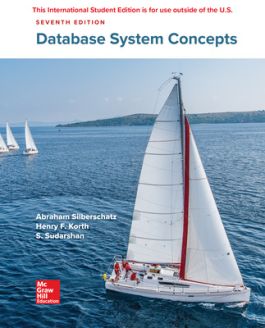ISE Database System Concepts
Part 1: Relational Languages
Chapter 2: Introduction to the Relational Model
Chapter 3: Introduction to SQL
Chapter 4: Intermediate SQL
Chapter 5: Advanced SQL
Part II: Database Design
Chapter 6: Database Design Using the E-R Model
Chapter 7: Relational Database Design
Part III: Application Design and Development
Chapter 8: Complex Data Types
Chapter 9: Application Development
Part IV: Big Data Analytics
Chapter 10: Big Data
Chapter 11: Data Analytics
Part V: Storage Management and Indexing
Chapter 12: Physical Storage Systems
Chapter 13: Data Storage Structures
Chapter 14: Indexing
Part VI: Query Processing and Optimization
Chapter 15: Query Processing
Chapter 16: Query Optimization
Part VII: Transaction Management
Chapter 17: Transactions
Chapter 18: Concurrency Control
Chapter 19: Recovery System
Part VIII: Parallel and Distributed Databases
Chapter 20: Database-System Architectures
Chapter 21: Parallel and Distributed Storage
Chapter 22: Parallel and Distributed Query Processing
Chapter 23: Parallel and Distributed Transaction Processing
Part IX: Advanced Topics
Chapter 24: Advanced Indexing Techniques
Chapter 25: Advanced Application Development
Chapter 26: Blockchain Databases
Part X: Appendix A
Appendix A: Detailed University Schema
Part XI: Online Chapters
Chapter 27: Formal Relational Query Languages
Chapter 28: Advanced Relational Database Design
Chapter 29: Object-Based Databases
Chapter 30: XML
Chapter 31: Information Retrieval
Chapter 32: PostgreSQL
The text is designed for a first course in databases at the junior/senior undergraduate level or the first year graduate level. It also contains additional material that can be used as supplements or as introductory material for an advanced course. Because the authors present concepts as intuitive descriptions, a familiarity with basic data structures, computer organization, and a high-level programming language are the only prerequisites. Important theoretical results are covered, but formal proofs are omitted. In place of proofs, figures and examples are used to suggest why a result is true.
McGraw Hill Connect is an award-winning digital teaching and learning solution that empowers students to achieve better outcomes and enables instructors to improve course management efficiency.
High-Quality Course Material
Our trusted solutions are designed to help students actively engage in course content and develop critical higher-level thinking skills while offering you the flexibility to tailor your course to the ways you teach and the ways your students learn.
Assignments & Automatic Grading
Connect features a question bank that you can select from to create homework, practice tests and quizzes. Dramatically reduce the amount of time you spend reviewing homework and grading quizzes, freeing up your valuable time to spend on teaching.
Analytics & Reporting
Monitor progress and improve focus with Connect’s visual and actionable dashboards. Reports are available to empower both instructors and students with real-time performance analytics.
Seamless Integration
Link your Learning Management with Connect for single sign-on and gradebook synchronization, with all-in-one ease for you and your students.


